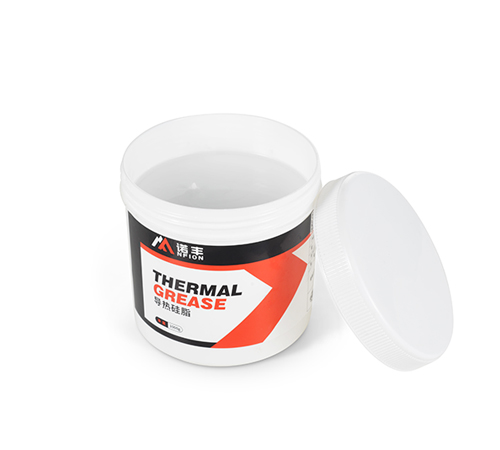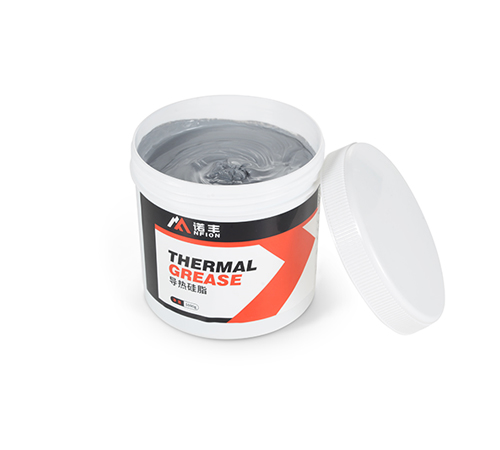
Thermal grease is a compound specifically designed to enhance thermal conductivity, typically existing in a paste-like form. It is primarily composed of silicone oil as the base oil, augmented with high thermally conductive fillers (such as aluminum oxide, boron nitride, graphite, etc.), antioxidants, and thickeners.
Production Process of Thermal Grease:
Raw Material Preparation
1.Silicone Oil: A key constituent of the grease, it is a transparent liquid with excellent thermal stability and low volatility, providing the fundamental heat transfer medium.
Mixing and Blending
2.Metal Powders: Depending on the formulation requirements, suitable metal powders (e.g., silver, aluminum, copper) are chosen. These powders possess high thermal conductivity, enhancing the grease's heat transfer properties.
3.Proportional Addition: Workers add silicone oil and metal powders into a mixer in strict proportions (one of the core technologies in production). This ratio determines crucial characteristics of the final product, such as thermal conductivity coefficient, viscosity, and operating temperature range.
4.Stirring: The mixture is thoroughly stirred within the mixer to ensure uniform dispersion of silicone oil and metal powders, forming a fine, flowable mixture. This process resembles kneading dough, necessitating the absence of granular clumps to guarantee that the grease forms a good contact surface when used, reducing thermal resistance.
Packaging and Sealing
5.Semi-finished Product Inspection: The uniformly mixed thermal grease undergoes preliminary quality checks to confirm compliance with expected physical properties.
6.Bagging: For small-dose applications, an automated or semi-automated device is used to package a precise amount (usually not exceeding 1 gram) of grease into plastic bags of pre-set dimensions, designed for single-use application, facilitating accurate application by users and preventing waste.
7.Drum Filling: In addition to bagging, large-scale drum filling may also occur, where the grease is filled into specialized sealed containers (such as plastic buckets or metal cans) for industrial-grade or bulk users.
Quality Control and Testing
8.Performance Testing: Using a professional heating platform simulating actual application scenarios, thermal conductivity tests are conducted on the thermal grease. During testing, the grease is applied between a heat source and a heatsink, a fixed installation pressure is maintained, and the temperature difference across the contact surface between the heat source and the heatsink is measured, thereby assessing the grease's heat transfer capability.
9.Additional Inspections: Besides thermal conductivity, the grease must undergo other necessary quality parameter inspections, such as viscosity, service life, chemical stability, electrical insulation, etc., ensuring the product meets all technical specifications and industry standards.
Labeling, Packaging, and Dispatch
10.Labeling & Packaging: Approved products are affixed with labels containing information like product name, model, specification, production date, expiration date, usage instructions, and placed in appropriate outer cartons to protect them from damage during transportation and storage.
11.Warehouse Exit & Sales: Products that have undergone comprehensive quality inspection and packaging are integrated into the inventory management system. They are arranged for shipment upon customer orders or directly supplied to sales channels.
Key Characteristics of Thermal Grease:
1.High Thermal Conductivity:
The core function of thermal grease lies in effectively transferring heat. When applied to the interface between heat-generating components (e.g., CPU, GPU, power modules, semiconductor chips) inside electronic devices and cooling devices (e.g., heatsinks, coolers, cooling substrates), it fills microscopic gaps and uneven areas, significantly reducing thermal resistance. This allows heat generated by the components to be transferred more rapidly and evenly to the cooling facilities, which then dissipate it into the environment through air convection, forced cooling by fans, etc., maintaining the stable operating temperature of electronic devices.
2.Low Thermal Resistance:
Owing to its good wetting and flow properties, thermal grease forms a continuous, ultra-thin layer on the contact surface, reducing contact thermal resistance. Compared to direct metal-to-metal contact, although metals themselves have higher thermal conductivity coefficients, in practical applications, due to factors such as machining precision, surface roughness, oxide layers, significant micro-gaps and air pockets often exist, greatly hindering heat transfer. Thermal grease fills these gaps, providing near-perfect thermal contact, ensuring heat transfer without hindrance.
3.Electrical Insulation:
In addition to exceptional thermal performance, thermal grease possesses good electrical insulation, allowing heat transfer while preventing short-circuit risks, ensuring the safe operation of electronic devices. This is particularly important in high-voltage, high-current circuit environments.
4.Chemical Stability & Weather Resistance:
Thermal grease typically exhibits excellent chemical stability, being resistant to moisture, oxidation, and having strong anti-aging properties. It does not react chemically with contacting materials. This characteristic enables it to maintain performance stability under various working conditions, while also providing some dustproof and corrosion-resistant protection, prolonging the service life of electronic devices.
5.Wide Operating Temperature Range:
Thermal grease usually maintains its physical properties over a wide temperature range, remaining fluid at low temperatures to accommodate thermal expansion changes during cold starts, and retaining stable thermal conductivity and electrical insulation properties at high temperatures, catering to the needs of electronic devices operating under high loads or high ambient temperatures.
6. Application & Spread Properties:
Thermal grease is easy to apply and can be evenly spread onto the contact surface between heat-generating components and heatsinks using tools like spatulas, brushes, or syringes. The applied thickness should be moderate, sufficiently filling interface gaps without creating excessive thermal resistance. After application, appropriate pressure (such as the tightening force during heatsink installation) can cause the grease to distribute evenly; excess grease around the edges can be cleaned off using lint-free cloths or similar tools.
Applications of Thermal Grease:
Thermal grease, as a crucial thermal management material, is widely employed in various electronic devices and industrial fields to ensure efficient, safe heat dissipation, preventing device damage or performance degradation caused by overheating. The following outlines the primary application domains and specific scenarios for thermal grease:
1.Computer Hardware:
Central Processing Unit (CPU): Thermal grease is applied between the CPU and the heatsink to fill the minute gaps between them, enhancing heat transfer and ensuring the substantial heat generated by the CPU is swiftly conveyed to the heatsink, subsequently dissipated into the environment via fans or heatsink fins.
Graphics Processing Unit (GPU): Similar to CPUs, high-end graphics cards' GPUs also require efficient cooling; thermal grease is used to fill the interface between the GPU core and cooling apparatus, ensuring effective heat transfer.
Random Access Memory (RAM): Some high-end or overclocked RAM modules may feature heatsinks, where thermal grease might be used to improve cooling efficiency.
Power Supply Unit (PSU): High-power or high-end power supplies may employ thermal grease to connect heat-generating elements like switching circuits, rectifier bridges, etc., to heatsinks, enhancing cooling.
2.Consumer Electronics:
Smartphones & Tablets: High-performance mobile devices' processors, graphics processors, radio frequency modules, and other critical heat-generating components may use thermal grease to connect to metal frames or heatsinks, facilitating heat dissipation.
Televisions & Monitors: Large-screen LCD televisions or professional monitors' internal processors, power modules, etc., may require thermal grease for auxiliary cooling.
Gaming Consoles: Home gaming consoles like PlayStation, Xbox, etc., have CPUs, GPUs, and other heat-generating components that commonly use thermal grease in conjunction with their cooling systems.
3.Industrial Electronics:
Power Electronic Devices: Including inverters, converters, servo drives, etc., internal power semiconductor devices (e.g., IGBTs, MOSFETs) connected to heat sinks or cooling substrates via thermal grease to reduce thermal resistance.
Communication Equipment: Microwave communication, microwave transmission equipment, base station equipment, and other high-power electronic devices, where heat-generating elements are thermally managed typically relying on thermal grease.
Automotive Electronics: In-vehicle electronic control systems, electric vehicle battery management systems (BMS), motor controllers (MCUs), and other components operating in high-temperature environments frequently utilize thermal grease to ensure reliable cooling.
4.Other Specific Applications:
LED Lighting: High-brightness LED luminaires, where thermal grease connects the LED chips and drive circuits to aluminum substrate heat sinks to prevent overheating affecting light output efficiency and lifespan.
Sensors: Certain sensors operating in high-temperature environments, such as infrared detectors, pressure sensors, etc., might use thermal grease to connect to cooling devices.
In addition to its direct use as a thermal interface material (TIM), thermal grease may also be combined with other cooling technologies, such as liquid cooling, heat pipes, or vapor chambers, forming complex and efficient cooling solutions. Moreover, due to its inherent moisture-proof, dust-proof, corrosion-resistant, and shock-resistant properties, thermal grease can provide additional protective functions under specific conditions, enhancing the overall reliability of electronic devices.

 CN >
CN >



